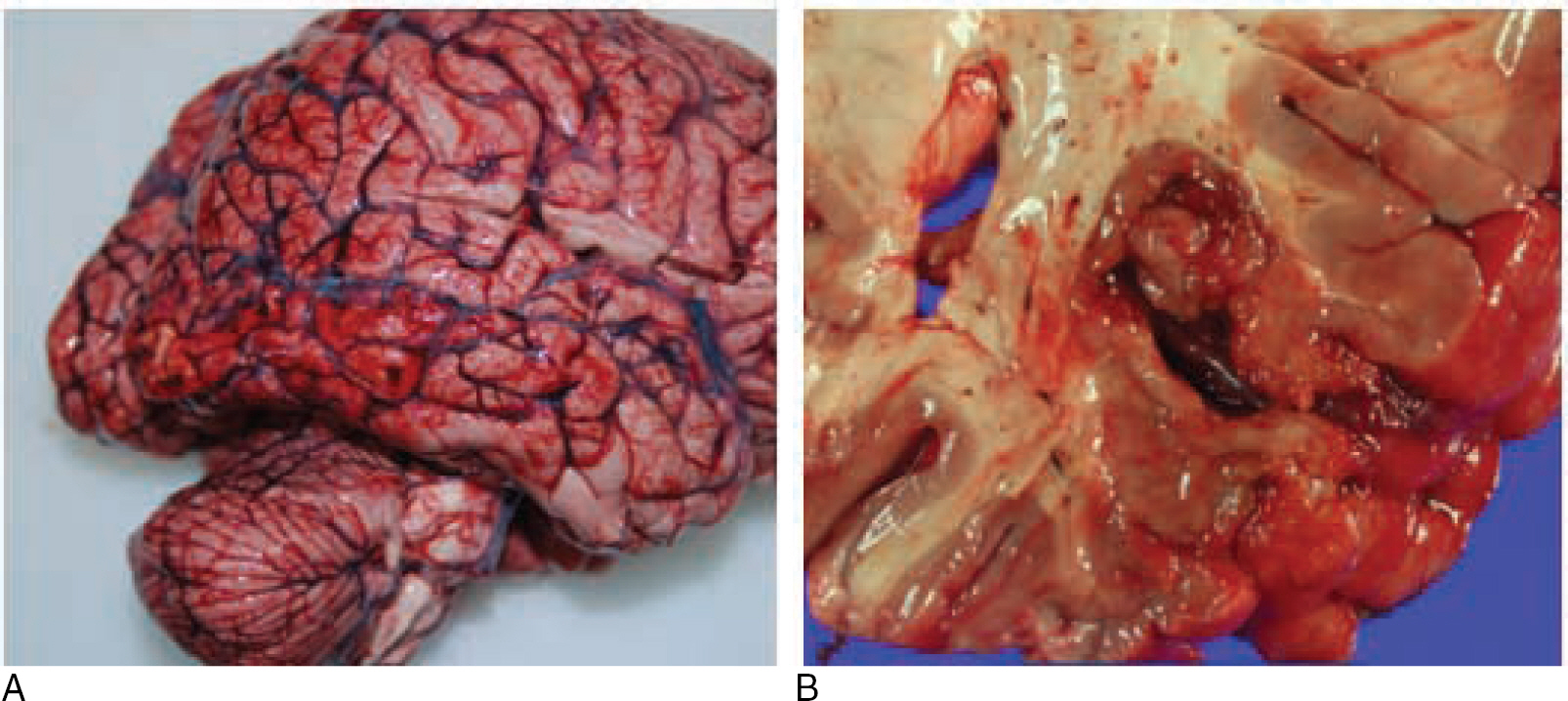Korean J Leg Med.
2015 Aug;39(3):67-72. 10.7580/kjlm.2015.39.3.67.
Determining the Cause of Natural Death: A Case of Previously Unknown Sturge-Weber Syndrome
- Affiliations
-
- 1Department of Forensic Medicine, Seoul National University College of Medicine, Seoul, Korea. sdlee@snu.ac.kr
- 2Medical Examiner's Office, National Forensic Service, Wonju, Korea.
- 3Department of Pathology, Seoul National University College of Medicine, Seoul, Koreas.
- 4Institute of Forensic Science, Seoul National University College of Medicine, Seoul, Korea.
- KMID: 2044951
- DOI: http://doi.org/10.7580/kjlm.2015.39.3.67
Abstract
- In some cases, it is difficult to determine a single cause of death even after conducting full autopsy and additional tests. A 49-year-old man, reportedly having diabetes mellitus, was found unconscious by his mother and revealed to be dead. He had several contusions all over his body, including the right periocular area, but they did not appear fatal. A focal area of polymicrogyria and cortical dysplasia was found on the right preoccipital notch, accompanied with dystrophic calcification and leptomeningeal angiomatosis. These findings were considered indicative of Sturge-Weber syndrome, a rare neurocutaneous disorder, of atypical type without facial lesions. Blood level of beta-hydroxybutyrate was 859 microg/mL, implying that he also had diabetic ketoacidosis. His ketoacidosis may not have been corrected appropriately because of status epilepticus in association with brain lesion, resulting in his death, but neither direct evidence nor statement was obtained. In cases with several apparent causes of death, the examiner's assumption should be based not on imagination but on evidence, and logic should not be overlooked. It is more helpful for the investigators or the bereaved to obtain more detailed information rather than come to a hasty conclusion.
MeSH Terms
Figure
Reference
-
1. Maton B, Krsek P, Jayakar P, et al. Medically intractable epilepsy in Sturge-Weber syndrome is associated with cortical malformation: implications for surgical therapy. Epilepsia. 2010; 51:257–67.
Article2. Jagtap S, Srinivas G, Harsha KJ, et al. Sturge-Weber syndrome: clinical spectrum, disease course, and outcome of 30 patients. J Child Neurol. 2013; 28:725–31.3. Geronemus RG, Ashinoff R. The medical necessity of evaluation and treatment of port-wine stains. J Dermatol Surg Oncol. 1991; 17:76–9.
Article4. Kitabchi AE, Umpierrez GE, Fisher JN, et al. Thirty years of personal experience in hyperglycemic crises: diabetic ketoacidosis and hyperglycemic hyperosmolar state. J Clin Endocrinol Metab. 2008; 93:1541–52.
Article5. Kanetake J, Kanawaku Y, Mimasaka S, et al. The relationship of a high level of serum beta-hydroxybutyrate to cause of death. Leg Med (Tokyo). 2005; 7:169–74.
Article6. Palmiere C, Bardy D, Mangin P, et al. Postmortem diagnosis of unsuspected diabetes mellitus. Forensic Sci Int. 2013; 226:160–7.
Article7. Palmiere C, Lesta Mdel M, Sabatasso S, et al. Unconsciousness and sedation as precipitating factors of diabetic ketoacidosis. J Forensic Leg Med. 2013; 20:830–5.
Article8. Park JP, Min BW, Na JY, et al. Sudden unexpected death of epileptic patient with dendriform pulmonary ossification. Korean J Leg Med. 2011; 35:53–6.9. Jang SJ, Kim KR, Kim HJ, et al. Death of a severe underweight infant with pulmonary interstitial glycogenosis. Korean J Leg Med. 2012; 36:178–81.
Article10. Na JY, Kim EH, Koo BY, et al. Cheese-like material in the heart: an autopsy case report of severe hypertriglyceridemia in diabetic ketoacidosis patient. Korean J Leg Med. 2013; 37:212–5.
Article



